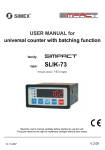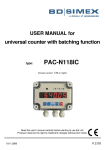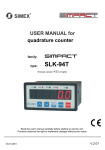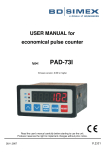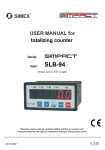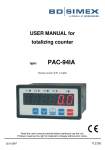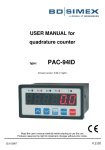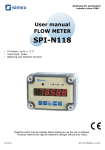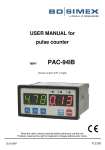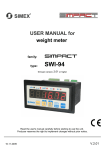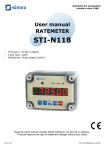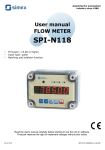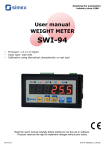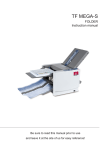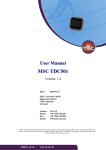Download SLIK-N118 - products
Transcript
Assisting the automation
industry since 1986
User manual
COUNTER
SLIK-N118
•
•
•
Firmware: v.8.10 or higher
Input type: pulse, quadrature
Batching function, wall mounting case IP 65
Read the user's manual carefully before starting to use the unit or software.
Producer reserves the right to implement changes without prior notice.
2013.10.28
SLIK-N118_INSSXEN_v. 2.05.003
User manual - COUNTER SLIK-N118
CONTENTS
1. BASIC REQUIREMENTS AND USER SAFETY........................................................................................3
2. GENERAL CHARACTERISTICS................................................................................................................4
3. TECHNICAL DATA......................................................................................................................................4
4. DEVICE INSTALLATION............................................................................................................................6
4.1. UNPACKING.......................................................................................................................................6
4.2. ASSEMBLY........................................................................................................................................7
4.3. CONNECTION METHOD...................................................................................................................7
4.4. MAINTENANCE................................................................................................................................13
5. FRONT PANEL DESCRIPTION................................................................................................................13
6. PRINCIPLE OF OPERATION...................................................................................................................14
6.1. MEASUREMENT MODE..................................................................................................................14
6.2. BATCHER FUNCTION.....................................................................................................................16
6.3. AUTOPRESCALER .........................................................................................................................18
6.4. THE DIGITAL FILTER......................................................................................................................18
6.5. CONTROL OF THE RELAY OUTPUTS..........................................................................................20
7. DEVICE PROGRAMMING.........................................................................................................................22
7.1. PROGRAMMING MENU..................................................................................................................22
7.2. PARAMETERS EDITION.................................................................................................................23
7.2.1. Numeric parameters (digit change mode)...............................................................................23
7.2.2. Numeric parameters (slide change mode)..............................................................................23
7.2.3. Switch parameters (“LIST” type).............................................................................................23
7.3. MENU DESCRIPTION.....................................................................................................................24
7.3.1. “rELAy” menu..........................................................................................................................24
7.3.2. “Funct” parameter....................................................................................................................25
7.3.3. “Pr inP” parameter...................................................................................................................26
7.3.4. “rESEt” parameter...................................................................................................................26
7.3.5. “ArESEt” parameter.................................................................................................................26
7.3.6. “FiLtEr” parameter...................................................................................................................27
7.3.7. “PArUPd” parameter................................................................................................................27
7.3.8. ”PrESCA” menu.......................................................................................................................27
7.3.9. ”rS-485” menu.........................................................................................................................28
7.3.10. ”SECu” menu.........................................................................................................................29
7.3.11. ”briGHt” parameter................................................................................................................31
7.3.12. ”Edit” parameter....................................................................................................................31
7.3.13. ”dEFS” parameter..................................................................................................................31
7.4. MENU STRUCTURE........................................................................................................................32
8. EXAMPLES OF PRESCALER PARAMETERS CALCULATION............................................................34
9. THE MODBUS PROTOCOL HANDLING.................................................................................................35
9.1. LIST OF REGISTERS......................................................................................................................35
9.2. TRANSMISSION ERRORS DESCRIPTION....................................................................................38
9.3. EXAMPLES OF QUERY/ANSWER FRAMES.................................................................................39
10. DEFAULT AND USER'S SETTINGS LIST.............................................................................................42
2
User manual - COUNTER SLIK-N118
Explanation of symbols used in the manual:
!
- This symbol denotes especially important guidelines concerning the installation and
operation of the device. Not complying with the guidelines denoted by this symbol
may cause an accident, damage or equipment destruction.
IF THE DEVICE IS NOT USED ACCORDING TO THE MANUAL THE USER IS
RESPONSIBLE FOR POSSIBLE DAMAGES.
i
- This symbol denotes especially important characteristics of the unit.
Read any information regarding this symbol carefully
1. BASIC REQUIREMENTS AND USER SAFETY
!
- The manufacturer is not responsible for any damages caused by
inappropriate installation, not maintaining the proper environmental
conditions and using the unit contrary to its assignment.
- Installation should be conducted by qualified personnel . During installation all
available safety requirements should be considered. The fitter is responsible for
executing the installation according to this manual, local safety and EMC
regulations.
- GND input of device should be connected to PE wire;
- The unit must be properly set-up, according to the application. Incorrect
configuration can cause defective operation, which can lead to unit damage or
an accident.
- If in the case of a unit malfunction there is a risk of a serious threat to the
safety of people or property additional, independent systems and
solutions to prevent such a threat must be used.
- The unit uses dangerous voltage that can cause a lethal accident. The unit
must be switched off and disconnected from the power supply prior to
starting installation of troubleshooting (in the case of malfunction).
- Neighbouring and connected equipment must meet the appropriate standards
and regulations concerning safety and be equipped with adequate overvoltage
and interference filters.
- Do not attempt to disassemble, repair or modify the unit yourself. The unit
has no user serviceable parts. Defective units must be disconnected and
submitted for repairs at an authorized service centre.
!
- Do not use the unit in areas threatened with excessive shocks, vibrations, dust,
humidity, corrosive gasses and oils.
- Do not use the unit in areas where there is risk of explosions.
3
User manual - COUNTER SLIK-N118
!
- Do not use the unit in areas with significant temperature variations, exposure to
condensation or ice.
- Do not use the unit in areas exposed to direct sunlight.
- Make sure that the ambient temperature (e.g. inside the control box) does not
exceed the recommended values. In such cases forced cooling of the unit must
be considered (e.g. by using a ventilator).
!
The unit is designed for operation in an industrial environment and must
not be used in a household environment or similar.
2. GENERAL CHARACTERISTICS
Universal programmable counter type SLIK-N118 is equipped with many modern
features required in simple and advanced automatic control systems. The counter had been
designed for hard environment conditions, and increased usefulness.
The unit is assembled in panel mounted case with programming keyboard on front panel,
and terminals on back panel. User can use local keyboard to set all necessary parameters due
to his own requirements. Build in RS-485 communication interface enables controlling of all
settings by host, and allows use of unit in advanced network systems.
Two counting inputs (pulse inputs) can operate in few different modes (as two
independent pulse inputs or single quadrature input). Additional programmable input can
change basic function of counting inputs (addition or subtraction of pulses from inputs, change
the direction of counting) or to stop counting without clearing.
Counter type SLIK-N118 is equipped with independent clearing input. The device can be
equipped with two relay (or OC type) outputs with independent threshold, which can be used to
control external devices. The counters SLIK-N118 are designed for cooperation with electronic
(PNP and NPN) detectors, and mechanical detectors – switches (build in digital filter allows
connectors denouncing). All inputs are separated from ground of counter, and power supply.
The meter can be ordered in three power supply versions.
The device has 5 buttons being used for main presets programming. To get high
protection level, the keyboard is mounted under transparent cover. To allow user to change
presets without opening the cover, an IR sensor is mounted. Remote controller keyboard is
equivalent to the device keyboard (Note, that remote controller is not a part of the SLIK-N118
set – it is an additional equipment).
3. TECHNICAL DATA
Power supply voltage
(depending on version)
85...230...260V AC/DC; 50 ÷ 60 Hz (separated)
or 19...24...50V DC and 16...24...35V AC (separated)
External fuse (required)
Power consumption
T - type, max. 2 A
max. 4.5 VA @ 85 ÷ 260V AC/DC
max. 4.5 VA @ 16V ÷ 35V AC
max. 4.5 W @ 19V ÷ 50V DC
4
User manual - COUNTER SLIK-N118
Pulse inputs
A and B inputs
C input
D input
COM
counting (terminal no. 9,10)
programmable (terminal no. 11)
reset counter (terminal no. 12)
common terminal (terminal no. 13)
Input levels
low level:
high level:
0V ÷ 1V
10V ÷ 30V
Max. input frequency
electronic - standard counter: 10 kHz
electronic - quadrature counter: 5 kHz
contact: 90 Hz (adjustable filter)
Display range
Outputs
relay:
OC-type:
sensor power supply UO:
-99999 ÷ 999999, plus decimal point
0 or 2 NO, 1A/250V AC (cos ϕ = 1)
0 or 2 30mA / 30VDC / 100mW
24V +5%, -10% / max. 100 mA, stabilized
Communication interface
RS 485, 8N1 and 8N2, Modbus RTU, not separated
Baud rate
1200 bit/s ÷ 115200 bit/s
Display
LED, 6 digit, 13mm height, red
Data memory
non-volatile memory, EEPROM type
Protection level
IP 65
Housing type
Housing material
Housing dimensions
without glands:
with glands:
wall mounted
ABS + fibreglass
Operating temperature
(depending on version)
0°C to +50°C
or -20°C to +50°C
Storage temperature
(depending on version)
-10°C to +70°C
or -20°C to +70°C
Humidity
Altitude
5 to 90% no condensation
up to 2000 meters above sea level
Screws tightening max. torque
Max. connection leads diameter
Safety requirements
0,5 Nm
2,5 mm2
according to: PN-EN 61010-1
installation category: II
pollution degree: 2
voltage in relation to ground: 300V AC
110 x 80 x 67 mm
110 x 105 x 67 mm
5
User manual - COUNTER SLIK-N118
insulation resistance: >20MΩ
insulation strength between power supply and
input/output terminal: 1min. @ 2300V
insulation strength between relays terminal:
1min. @ 1350V
according to: PN-EN 61326-1
EMC
!
This is a class A unit. In housing or a similar area it can cause radio
frequency interference. In such cases the user can be requested to use
appropriate preventive measures.
4. DEVICE INSTALLATION
The unit has been designed and manufactured in a way assuring a high level of user
safety and resistance to interference occurring in a typical industrial environment. In order to
take full advantage of these characteristics installation of the unit must be conducted correctly
and according to the local regulations.
!
- Read the basic safety requirements on page 3 prior to starting the installation.
- Ensure that the power supply network voltage corresponds to the nominal
voltage stated on the unit’s identification label.
- The load must correspond to the requirements listed in the technical data.
- All installation works must be conducted with a disconnected power supply.
- Protecting the power supply clamps against unauthorized persons must be
taken into consideration.
4.1. UNPACKING
After removing the unit from the protective packaging, check for transportation damage. Any
transportation damage must be immediately reported to the carrier. Also, write down the unit
serial number on the housing and report the damage to the manufacturer.
Attached with the unit please find:
- user’s manual,
- warranty,
6
User manual - COUNTER SLIK-N118
4.2. ASSEMBLY
!
!
- Disconnect the power supply prior to starting assembly.
- Check the connections are wired correctly prior to switching the unit on.
To install device on the wall, a pinholes should be made. Figure 4.1 presents
dimensions of the device and distances between holes. The back side of the device
has four mounting holes. This part of the case should be mounted to a wall by
screws.
110 mm
67 mm
60 mm
80 mm
90 mm
.4
ø4
ø8
.4
Figure 4.1. Device and assembly dimensions
4.3. CONNECTION METHOD
Caution
!
- Installation should be conducted by qualified personnel . During installation all
available safety requirements should be considered. The fitter is responsible for
executing the installation according to this manual, local safety and EMC
regulations.
- The unit is not equipped with an internal fuse or power supply circuit breaker.
Because of this an external time-delay cut-out fuse with minimal possible nominal
current value must be used (recommended bipolar, max. 2A) and a power supply
circuit-breaker located near the unit. In the case of using a monopolar fuse it must
be mounted on the phase cable (L).
- The power supply network cable diameter must be selected in such a way that in
the case of a short circuit of the cable from the side of the unit the cable shall be
protected against destruction with an electrical installation fuse.
- Wiring must meet appropriate standards and local regulations and laws.
7
User manual - COUNTER SLIK-N118
!
- In order to secure against accidental short circuit the connection cables must be
terminated with appropriate insulated cable tips.
- Tighten the clamping screws. The recommended tightening torque is 0.5 Nm.
Loose screws can cause fire or defective operation. Over tightening can lead to
damaging the connections inside the units and breaking the thread.
- In the case of the unit being fitted with separable clamps they should be inserted
into appropriate connectors in the unit, even if they are not used for any
connections.
- Unused clamps (marked as n.c.) must not be used for connecting any
connecting cables (e.g. as bridges), because this can cause damage to the
equipment or electric shock.
- If the unit is equipped with housing, covers and sealing packing, protecting
against water intrusion, pay special attention to their correct tightening or clamping.
In the case of any doubt consider using additional preventive measures (covers,
roofing, seals, etc.). Carelessly executed assembly can increase the risk of electric
shock.
- After the installation is completed do not touch the unit’s connections when it is
switched on, because it carries the risk of electrical shock.
Due to possible significant interference in industrial installations appropriate measures
assuring correct operation of the unit must be applied. To avoid the unit of improper
indications keep recommendations listed below.
–
Avoid common (parallel) leading of signal cables and transmission cables together with
power supply cables and cables controlling induction loads (e.g. contactors). Such cables
should cross at a right angle.
–
Contactor coils and induction loads should be equipped with anti-interference protection
systems, e.g. RC-type.
–
Use of screened signal cables is recommended. Signal cable screens should be
connected to the earthing only at one of the ends of the screened cable.
–
In the case of magnetically induced interference the use of twisted couples of signal
cables (so-called “spirals”) is recommended. The spiral (best if shielded) must be used
with RS-485 serial transmission connections.
–
In the case of measurement or control signals are longer than 30m or go outside of the
building then additional safety circuits are required.
–
In the case of interference from the power supply side the use of appropriate antiinterference filters is recommended. Bear in mind that the connection between the filter
and the unit should be as short as possible and the metal housing of the filter must be
connected to the earthing with largest possible surface. The cables connected to the filter
output must not run in parallel with cables with interference (e.g. circuits controlling relays
or contactors).
8
User manual - COUNTER SLIK-N118
Connection of the power supply, and the measurement and controlling signals should be
made by clamping connectors mounted inside the housing.
6 mm
max. 1.6 mm
b)
max. 2 mm
a)
5 mm
Figure 4.2. Recommended dimensions of cable stripping
a) for big connectors (1 to 6), b) for small connectors (7 to 13, 15 to 17)
Figure 4.3. Method of connecting cables to the clamping connectors
!
All connections must be made while power supply is disconnected !
9
User manual - COUNTER SLIK-N118
R1
R2
(option)
(option)
6 5
4 3
RS - 485
C
B
A + Uo
-
24V (+5%, -10%)
Imax = 100 mA
(depending
on version)
COM D
2 1
Power supply
PE
DATA+
DATA-
GND
17 16 15 14 13 12 11 10 9 8 7
Figure 4.4. Terminals description (relay outputs)
OC1, OC2: Umax = 30V DC,
Imax = 30mA, Pmax = 100mW
COM D
C
B
A + Uo
OC2
(option)
-
-
+
6 5
4 3
-
24V (+5%, -10%)
Imax = 100 mA
Figure 4.5. Terminals description (OC-type outputs)
Description of control signals' symbols.
{ A },{ B }
{C}
{D}
{ COM }
10
- counting input, pulse;
- programmable input;
- reset counter input;
- common terminal
+
2 1
(depending
on version)
PE
DATA+
DATA-
GND
17 16 15 14 13 12 11 10 9 8 7
OC1
(option)
Power supply
RS - 485
User manual - COUNTER SLIK-N118
R1
R2
N L
6 5 4 3
2 1
FUSE
FUSE
N
L
Depending on version:
85...230...260V AC/DC; 50 ÷ 60 Hz or
19...24...50V DC and 16...24...35V AC
Figure 4.6. Connection of power supply and relays
!
Contacts of relay outputs are not equipped with spark suppressors. While use
the relay outputs for switching of inductive loads (coils, contactors, power
relays, electromagnets, motors etc.) it is required
to use additional
suppression circuit (typically capacitor 47nF/ min. 250VAC in series with
100R/5W resistor), connected in parallel to relay terminals or (better) directly
on the load. In consequence of using the suppression circuit, the level of
generated electromagnetic disturbances is lower, and the life of relay contacts
rises.
a)
L
6 5
b)
L
6 5
!
!
N
N
Figure 4.7. Examples of suppression circuit connection:
a) to relay terminals; b) to the inductive load
11
User manual - COUNTER SLIK-N118
Uo
Uo
OC1
8 7
+
8 7
6 5
-
-
OC1
+
+
6 5
-
-
+
Logic controller
-
+
R
2k2
LED 10 mA
voltage input
24 V
Figure 4.8. Example of OC-type outputs connection
Construction of counter's inputs allows connecting of pulser with common earth (Figure 4.9 a)
or common plus (Figure 4.9 b), without additional intermediary circuits (sensor with NPN or
PNP type output); for outputs of push-pull type kind of connection it has no matter.
a)
b)
COM D
C
B
A
+
-
COM D
13 12 11 10 9 8 7
C
RESET
RESET
STOP
STOP
+
+
+
+
-
-
-
-
Impulsatory
Impulsatory
Figure 4.9. An example of pulser connection:
a) with common earth, b) with common plus.
12
B
A
+
-
13 12 11 10 9 8 7
User manual - COUNTER SLIK-N118
4.4. MAINTENANCE
The unit does not have any internal replaceable or adjustable components available to
the user. Pay attention to the ambient temperature in the room where the unit is operating.
Excessively high temperatures cause faster ageing of the internal components and shorten the
fault-free time of unit operation.
In cases where the unit gets dirty do not clean with solvents. For cleaning use warm water with
small amount of detergent or in the case of more significant contamination ethyl or isopropyl
alcohol.
!
Using any other agents can cause permanent damage to the housing.
Product marked with this symbol should not be placed in municipal waste. Please
check local regulations for disposal and electronic products.
5. FRONT PANEL DESCRIPTION
Inactive LED (AL)
infrared
receiver
R1
AL
Thresholds exceeding
LED indicators (R)
R2
display
ESC
MENU
ENTER RESET
programming pushbuttons
Symbols and functions of push-buttons:
ESC
MENU
ENTER
Symbol used in the manual: [ESC/MENU]
Functions:
• Enter to main menu ( press and hold by at least 2 sec.)
• Exit the current level and Enter to previous menu (or measure mode)
• Cancel the changes made in parameter being edited
Symbol used in the manual: [ENTER]
Functions:
• Start to edit the parameter
• Enter to the sub-menu,
• Confirmation of changes made in parameter being edited
Symbol used in the manual: [^]
Functions:
• Change of the present menu,
• Modification of the parameter value,
• Monitoring of current thresholds and offset,
13
User manual - COUNTER SLIK-N118
Symbol used in the manual: [v]
Functions:
• Change of the present menu,
• Modification of the parameter value,
RESET
Symbol used in the manual: [RESET]
Functions:
• zeroing the counter (see: „rESEt” option, page: 26), the reset must be
confirmed by [ENTER] button.
6. PRINCIPLE OF OPERATION
After turning the power supply on, device ID and software version are showed on the
display, next the data stored while power supply off are restored and device goes to the
selected operation mode.
6.1. MEASUREMENT MODE
In the counting mode (normal mode), the device counts pulses “delivered” to counting
inputs A and B (Figure 6.1) depends on selected function. There are available four functions:
addition of pulses from A and B inputs (“Funct”=”A ╫ b”), subtraction of pulses from A and B
inputs (“Funct” = ”A -- b”), quadrature counting with standard resolution (“Funct” =”quad-1”) ,
quadrature counting with increased resolution (“Funct” =”quad-4”).
14
User manual - COUNTER SLIK-N118
a)
A input
B input
Display result
for mode:
A+B
A-B
0
1
2
3
4
5
7
9
10
11
0
1
2
1
2
1
1
1
0
-1
b)
A input
B input
Display result
for mode:
quAd-4
quAd-1
0
0
1
2
3
1
4
5
6
7
2
8
9
10
11
3
10
9
8
7
6
2
5
4
3
2
1
Figure 6.1. The counting principle of the SLIK counters
(parameters: muL=”1”, div=”1”, oFFSEt=”0”):
a) modes ”A+B”, ”A-B”; b) modes ”quAd-4”, ”quAd-1”
Counter recalculates result using three parameters - mul, div and offset, and shows it on the
display. If the result is out of permissible counter range (from“-99999” to “999999”), special
warning is displayed in place of the result. The warning type depends on the result and can be:
– “-Hi-” - if the result is higher than “999999”,
– “-Lo-” -if the result is lower than“-99999”,
Any time the counter can be zeroed at by:
– pressing of the [RESET] push-button and the confirmation of the [ENTER] button,
– activating the external reset input (see: “rESEt” menu),
– presets of the internal registers via RS-485 interface.
After zeroing, the result equal to the “oFFSEt“ parameter is displayed. (see: “PrESCA”
menu).
15
User manual - COUNTER SLIK-N118
In the measurement mode user can check main thresholds values. After pressing [^]
button, name of the threshold (e.g. ”rELPr1”) and it's value will be displayed on the display in
alternating mode. When the batcher mode is active, additionally the ”oFFSEt” parameter can
be checked. If [^] or [v] will be pressed in 5 sec again, the next threshold or offset will be
displayed, else the device comes back to the measurement mode. If a thresholds values
free access is enabled or thresholds and offset values free access is enabled (see: ”SECu”
menu), user can change the value of particular parameter pressing button [ENTER] (see:
PARAMETERS EDITION).
All accessible parameters can be changed by entering the menu (see: DEVICE
PROGRAMMING). Use the local keyboard or the remote controller to do it. (Note: all
parameters can be remote changed via RS-485 interface).
i
•
•
Counting and relays controlling are independent of operation mode of the
counter. They are continued (in background) even in menu mode, but in such
case maximal input frequency should be not greater than 8 kHz.
If ”PArUPd” option is set to ”on rES” mode, then change of parameters
”muL”, ”div”, ”oFFSEt”, ”Point” and all parameters of the relays controlling
(see ”rELAy” menu), has no influence on current counting process. In this
mode changed parameters will be applied after reset (manual or automatic) or
next device power up. If ”PArUPd” option is set to ”immEd” mode, then all
changes of these parameters are applied immediately.
6.2. BATCHER FUNCTION
To use counter SLIK-N118 as a batcher, proper connection to controlled circuit must be
done (e.g. valves and flow detector) and parameter “A oFFS” must be set to “on” option (see
description of ”SECu” menu). In example showed on page 17 producer assumes use of two
valves: main (biger) and additional (smaller).
To use the counter as a batcher (it means to counter displays how much of some fluid should
be poured to fill tank) parameter ”Funct” should be set to option allowed subtraction of pulses
delivered to counting inputs. If programmable input { C } is used to change direction of
counting (see description of ”Pr inP” parameter), state of this input must be taken into
consideration.
Allowable connection methods and counter configurations are showed in table 6.1.
used
counting input
”Funct”
parameter
“Pr inP”
parameter
state of
”C” input
B
”A - B”
”dirEct”
no active
B
”A - B”
other than ”dirEct”
any
A
”A - B”
”dirEct”
active
A or B
”A + B”
”dirEct”
active
A and B
”quAd 1” or ”quAd 4”
”dirEct”
no active
A and B
”quAd 1” or ”quAd 4”
other than ”dirEct”
any
B and A
”quAd 1” or ”quAd 4”
”dirEct”
active
Tab. 6.1. Possible configurations while use device as a batcher
16
User manual - COUNTER SLIK-N118
Amount of poured fluid can be changed by parameter “oFFSEt”, which is showed first in
quick view mode, while parameter “A oFFS” = “on” (see page 31). Proposed in example
system is showed in Figure 6.2, and proposed circuit diagram in Figure 6.3.
More details of this example are described on page 34.
Flow detector
main valve,
controlled by relay R1
additional valve,
controlled by relay R2
tank
pulses to „B“ input
Figure 6.2. Proposed system
3 4 5
R2
R1
8 9 10 11 12
B
D
COM
START
pouring
+
Supply
24V DC
B
+
Flow detector
Additional
valve
Main
valve
Controlled system
Figure 6.3. Proposed circuit diagram
17
User manual - COUNTER SLIK-N118
6.3. AUTOPRESCALER
This feature allows easy setting of counter prescaler (“muL”, “div” and ”Point”) to
desired number of pulses per unit and displayed value together with decimal point position.
To enter this function select ”AutoPr” option of ”PrESc” submenu and press [ENTER]
button. After that „ run ?” message is displayed to avoid of accidental clearing of current
settings. Press [ENTER] again to acknowledge and start the procedure. Counter sets default
values of its parameter first ( Notice, that current counter value is being cleared without saving)
and goes to counting desired number of pulses per unit (parameter ”div”).
The device displays „StArt” message and waits until user deliver any pulses to counting
input, after that displays current number of pulses. User should connect cooperating device to
the counter and generate as number of pulses as is essential to display desired value. After
counting press [ENTER].
In next step message ”SEtVAL” is displayed, and counter waits for entering value which
should be shown for just counted number of pulses ( it is ”muL” parameter). Press [ENTER]
again to start edit this value, remember that value is displayed without decimal point, and user
should enter whole value with desired fractional positions. Approve entered value pressing and
holding [ENTER] about 2 seconds.
Next step is selection of decimal point position (parameter ”Point”). Counter displays
”SetPnt” message and waits for acknowledge. Press [ENTER] and select point position.
Approve it pressing [ENTER] again. After whole procedure entered values are stored into
configuration memory, and value of OFFSET parameter is cleared.
i
To break autoscaling press [ESC/MENU] at any time. This operation causes with
restoring of all parameters “muL”, “div” and ”Point” as they was defined before
starting Autoscaling. The value of the counter is not restored.
6.4. THE DIGITAL FILTER
To enable the connection of the simple switches as detectors, special digital filter has
been build into the device. This filter allows the counter to proper counting pulses regardless of
the vibration of the contacts of the switches.
The condition of proper counting is providing of time periods of the pulses. The filter can
be set to blocking frequencies higher than 10, 20, 30, 40, 50 ,60 ,70, 80 and 90Hz. The time
periods of stable states "0" (t0) and "1" (t1) of pulses must be not shorter than 1/2F, where F
the filtered frequency in Hz. See the table below (Tab. 6.2) to check proper periods for all
frequencies.
18
filter setting (F)
t0 , t 1
input signal
frequency
input type
OFF
50,0 µs /
100,0 µs
10 kHz /
5 kHz
electronic
input
10
50,0 ms
10 Hz
20
25,0 ms
20 Hz
30
16,7 ms
30 Hz
electronic
40
12,5 ms
40 Hz
or contact
User manual - COUNTER SLIK-N118
filter setting (F)
t0 , t 1
input signal
frequency
input type
50
10,0 ms
50 Hz
input
60
8,3 ms
60 Hz
70
7,2 ms
70 Hz
80
6,3 ms
80 Hz
90
5,6 ms
90 Hz
Tab. 6.2. Time periods t0 ,t1 depend on filtered frequency.
When the filter is turned off , time periods t0 i t1 must be longer than 50 µs (see Figure 6.4),
and maximum counted frequency is equal 10 kHz.
a)
t0
t1
Moments of pulses counting
b)
t0
t1
oscillations
Moments of pulses counting
Figure 6.4. The traces of signals:
a) without contacts oscillations, b) with contacts oscillations
19
User manual - COUNTER SLIK-N118
6.5. CONTROL OF THE RELAY OUTPUTS
The control of the object (measured signal) is realized via relay outputs. Front panel LEDs
named „R” indicates the state of particular relay output.
Modes of the control can be changed depend on the values of parameters “SEtP”, “timE”,
“unit” and “modE” (additional number defines particular relay).
Figure 6.5 presents the principle of relay outputs operation for example values of
parameters.
tA
displayed result
tC
current
counter
value
tG
tE
“SEtP” parameter
(threshold value)
a)
D
A
tZ
b)
c)
d)
e)
G
closed
relay state
(modE = oFF
timE = 0)
relay state
(modE = oFF
timE > 0)
F
time
relay state
(modE = on
timE = 0)
relay state
(modE = on
timE > 0)
E
C
B
open
time
closed
time
open
closed
open
“timE”
“timE”
tX
“timE”
“timE”
tX
“timE”
time
closed
open
“timE”
time
Description:
A, B, C, D, E, F, G
tA , tC , tE , tG
tX
tZ
- time points where result exceeds thresholds value,
- time while counter keeps result at least equal to threshold value
- time between subsequent exceeds of threshold value (shorter than value of “timE”parameter )
- delay of relay reaction
Figure 6.5. Principle of relay outputs operation
Parameter “SEtP” defines threshold of relay (trace: a). While normal operation of
counter, relay output can change its state to active only if counter value reaches (or exceeds)
the threshold (for „up” counting points A, C, E, G ). The active state of the relay (closed or
open) is defined by parameter “modE”. Relay R1 reacts to counter value changes
immediately. Other relays (if available) need that counter value be same or greater than
particular threshold during at least 20 ms, to change the relay state.
20
User manual - COUNTER SLIK-N118
It is possible to set AUTORESET function for relay R1. This function enables automatic
zeroing of the counter, after its value reaches relay R1 threshold (if “ArESEt”=“on Pr1”) or
after its value is lower than 0 (if “ArESEt”=“on 0”). After zeroing, counter's value equals to
“oFFSEt” parameter (if “ArESEt”=“on Pr1”) or [SEtP 1 + “oFFSEt” - 1] value (if
“ArESEt”=“on 0”).
If AUTORESET function is active, then relays other than R1 (if available) can be activated if
their thresholds are not greater than relay R1 threshold (if “ArESEt”=“on Pr1”) or not lower
than 0 (if “ArESEt”=“on 0”).
Maximum delay between the moment when result reaches the particular threshold and
switching on the relay output equals 15ms for OC type output and 20ms for electromechanical
relays.
i
If AUTORESET function is active, and counter changes its value with high speed,
relays other than R1 (if available) can not change it's states to active, because the
time between moments when counter reaches their thresholds and threshold value
of relay R1 (greater than for other relays thresholds) is to short.
While AUTORESET function is active some conditions must be fulfilled:
– If “ArESEt”=“on Pr1” then „oFFSEt” < ”SEtP 1”
– If “ArESEt”=“on 0” then „oFFSEt” + ”SEtP 1” > 0
If these conditions will not be fulfilled then counter can work improperly or can't work
at all.
Parameter “timE” defines how long relay stay active after its activation by counter value (after
moment when counter has reached particular threshold).
• If parameter “timE” is set to “0”, than relay stays in active state (periods: tA ,tC ,tE ,tG) as
long as counter value is equal or higher than threshold value. (traces: b, c).
• If parameter “timE” is set to value different from “0”, than relay stay active during defined
time regardless of counter value (traces: d, e). In case when period (tX) between
successive exceeding of threshold value (e.g. between points B and C) is shorter than
period defined by parameter “timE”, activation period of relay is prolonged by “timE”
(every time when counter value goes up and reaches threshold).
i
If parameter “timE1” = “0” and AUTORESET function is active, relay R1 will not
change it's state to active or will be activated on very short time because of delays. If
user wants to not use particular relay (especially relay R1), its mode of operation
should be set to ”noAct” (e.g. „mode 1” =”noAct”).
Parameter “modE” can be set to value “modbuS”. In such case it is possible to drive
relays via RS-485 interface. In this case relays are independent on counter value, and „time”
and „SEtP” settings, and change of it's state can be done exclusively via RS-485 interface, as
presets of holding registers (see: LIST OF REGISTERS) . While parameter “modE” is set to
value ”on” or ”oFF”, presets of these registers do not causes any reaction, and reading of
these registers show actual state of particular relays.
i
If “modbuS” mode is active, than after power down and up relays are inactive.
All parameters corresponding to relay outputs are described in details in chapter
”rELAy” menu.
21
User manual - COUNTER SLIK-N118
7. DEVICE PROGRAMMING
The device menu allow user to set all parameters connected to operation of
measurement input, control modes, critical situations behaviour, communication via RS-485
and access settings. The meaning of the particular parameters is described in paragraph
MENU DESCRIPTION.
Some of the parameters can be accessed without menu entering (quick view mode).
After pressing [^] button, name of the threshold (e.g. ”rELPr1”) and it's value will be displayed
on the display in alternating mode. When the batcher mode is active, additionally the
”oFFSEt” parameter can be checked. If [^] or [v] will be pressed in 5 sec again, the next
threshold or offset will be displayed, else the device comes back to the measurement mode. If
a thresholds values free access is enabled or thresholds and offset values free access is
enabled (see: ”SECu” menu) , user can change the value of particular parameter pressing
button [ENTER] (see: PARAMETERS EDITION).
i
If particular parameter has been changed and confirmed in quick view mode, its
new value is displayed in alternating mode with parameter name by few seconds.
Confirmed changes may be checked or user can switch viewed parameter pressing
[^] or [v] button.
7.1. PROGRAMMING MENU
To enter main menu (being in the measurement mode) operator must to press and hold
at least 2 sec. [ESC/MENU] button. If the user password is defined (see parameter “SEtCod“,
menu ”SECU”), operator have to enter correct one before proceeding to menu options.
Entering of the passwords is similar to the edition of numeric parameters (see: PARAMETERS
EDITION), however presently editing digit is showed only on the display, other digits are
replaced by “-” sign.
After entering of last digit of the password first menu position will be displayed (if the
password is correct) or warning ”Error” in other case.
!
Pay attention when device parameters are being changed. If it is possible, turn off
controlled installation (machine).
Functions of the buttons while sub-menu and parameters choice:
Selection of sub-menu or parameter for editing. Name of selected item (submenu or parameter) is displayed.
ENTER
MENU
[ESC/MENU] button allow user to exit present menu level and goes to upper
level menu (or measurement mode).
i
After about 1 min. since last use of the buttons, device exits the menu mode and
returns to the measurement mode (only if no parameters are in editing mode).
ESC
22
Operation of [ENTER] button depend on present menu position:
• if the name of some sub-menu is displayed - enter this sub-menu; name
of the first parameter (or next level sub-menu) is displayed,
• if the name of some parameter is displayed - enter the edition of this
parameter; present value of the parameter is displayed,
User manual - COUNTER SLIK-N118
7.2. PARAMETERS EDITION
To start edition of any parameter user should select name of desired one using [^] [v]
buttons and then press [ENTER].
7.2.1. Numeric parameters (digit change mode)
Numerical parameters are displayed as decimal numbers. The mode of its new value entering
depends on chosen edit method ( see parameter „Edit”).
In mode “by digit” („Edit”=”dig”) pressing one of the keys [^] or [v] causes change of
current position (flashing digit) or the sign (+/-). Short pressing of the [ENTER] button causes
change of the position (digit).
Press [ENTER] at least 2 seconds to accept the changes, after that question ”SEt?” is
displayed, and user must to confirm (or cancel) the changes. To conform changes (and story it
in EEPROM) press [ENTER] button shortly after ”SEt?” is displayed. To cancel the changes
press [ESC] button shortly after ”SEt?” is displayed. After that device returns to the menu.
7.2.2. Numeric parameters (slide change mode)
In “slide change” mode („Edit”=”Slid”), buttons [^] and [v] has different functions.
To increase edited value press (or press and hold) [^] button only, the increasing
became quickest as long as button [^] is pressed. To slow down the increasing, button [v] can
be used. If [v] is pressed shortly (and button [^] is still pressed), increasing slow down for
a moment only, if [v] is pressed and held while button [^] is still pressed the increasing slow
down and will be kept on lower speed.
To decrease edited value press (or press and hold ) [v] button only. The decreasing
became quickest as long as button [v] is pressed. To slow down the decreasing, button [^]
can be used. If [^] is pressed shortly (and button [v] is still pressed), decreasing slow down for
a moment only, if [^] is pressed and held while button [v] is still pressed the decreasing slow
down and will be kept on lower speed.
Press [ENTER] at least 2 seconds to accept the changes, after that question ”Set?” is
displayed, and user must to confirm (or cancel) the changes. To conform changes (and story it
in EEPROM) press [ENTER] button shortly after ”SEt?” is displayed. To cancel the changes
press [ESC] button shortly after ”SEt?” is displayed. After that device returns to the menu.
7.2.3. Switch parameters (“LIST” type)
Switch parameters can be described as a sets of values (a lists) out of which only one of
the options available on the list can be selected for the given parameter. Options of switching
parameter are selected using [^], [v] keys.
Short pressing of [ENTER] causes in displaying of the acknowledge question (”SEt?”). If
key [ENTER] is pressed again, the changes are accepted, stored in EEPROM end the edition
process finished. Pressing the key [ESC] after ”SEt?” causes in cancelling of made changes
and returning to menu.
Functions of buttons when editing numeric and switching parameters:
23
User manual - COUNTER SLIK-N118
While editing numeric parameter:
• change of current (flashing) digit
• slide change of value (acceleration, deceleration, direction change)
While editing switch parameter - selection of switch parameter.
If numerical parameter is being edited, a short press of [ENTER] button
change edited position. A long press of [ENTER] button (at lest 2 sec.)
causes of display a ”SEt?” ask, which allow user to make sure if change of
the parameter value is correct. If switch parameter is being edited, a short
press of [ENTER] button causes of display a ”SEt?” ask. When [ENTER]
button is pressed again (while ”SEt?” is displayed) the new value of the
parameter is stored in EEPROM memory.
ENTER
Pressing this button operator can cancel the changes done up to now (if they
were not approved by [ENTER] button after the ”SEt?” ask) and come back
to menu
ESC
MENU
7.3. MENU DESCRIPTION
“Cd 0 - - -”
i
Password checking. If password is set different from „0000”, than every enter to
main menu follows the entering of password. If entered password is correct first
menu position else warning ”Error” will be displayed, and unit returns to
measurement mode.
Due to problem with direct displaying of “m” letter, it is exchanged with special sign
“
“. Independently in user manual letter „m” is used to make it more readable
(example: “modE”).
7.3.1. “rELAy” menu
This menu allows to configure the operation mode of relays and LEDs marked „R” (e.g.
„R1”). If there are few relay outputs available, then every output has its own configuration
menu (e.g. menu „rELAy2” for relay (LED) „R2”). Principle of the relays operation is described
in paragraph CONTROL OF THE RELAY OUTPUTS.
i
If ”PArUPd” option is set to ”on rES” mode, then change of parameters ”muL”,
”div”, ”oFFSEt”, ”Point” and all parameters of the relays controlling (see ”rELAy”
menu), has no influence on current counting process. In this mode changed
parameters will be applied after reset (manual or automatic) or next device power
up. If ”PArUPd” option is set to ”immEd” mode, then all changes of these
parameters are applied immediately.
“SEtP”
- threshold of the relay (range -99999 ÷ 999999). Negative values can be input by
selecting a “-” sign on first digit (to change value use [^] and [v] buttons).
“modE”
- relay operation mode, this parameters define the active state of the relay, it
means state of relay while the counter reaches threshold value, at “up counting”,
available modes:
24
User manual - COUNTER SLIK-N118
“noAct”
- the relay is not active (permanent turned off)
“on”
- the relay is turned on (closed) when result reaches threshold value
“oFF”
- the relay is turned off (opened) when result reaches threshold value
“modbuS”
- the relay is controlled via RS-485 interface, independently on the
counter result and parameters “SEtP” and “timE”.
i
“timE”
i
“unit”
•
•
When a particular LED lights, its mean the relay is closed,
If parameter “modE” is set to “modbuS” value, after power supply off and on
again, relays are open.
- the time period of the relay active state. Can be set to values from ”0.1” to ”99.9”,
and express the time in seconds or minutes (depending on ”unit” parameter). If
this parameter is set to value different from „0.0” the relay is active independently
of the result (even if the counter is zeroed). If this parameter is set to „0.0” the
relay stays active as long as the result is same or higher of the particular
threshold value.
If this parameter is set to „0.0”, and the AUTORESET function is active, the counter
will be zeroed but relays can stay inactive or will be activated on very short time
because of delays. If user wants to not use particular relay, its mode of operation
should be set to ”noAct” (e.g. „mode 1” =”noAct”).
- unit of time for “timE” parameter. Can be set on one of two values:
“min”
“SEC”
“rEF”
- minutes,
- seconds.
- reference point (offset) of relay threshold. Available values:
“Std”
- use 0 value as reference point (offset)
“rELPr1” - use threshold of the relay R1 as reference point (offset)
i
This parameter is not available for relay R1. If rELPr1 option is set, then relay
threshold is modified by relay R1 threshold (“SEtP 1” value). It means that state of
relay (different than R1) will be changed earlier or later in reference to value of the
relay R1 threshold.
7.3.2. “Funct” parameter
This parameter allows to define operation mode of the counter, and can be set to one of
the values:
”A + B”
- add mode; addition of pulses from both counting inputs (A and B) to current
counter result.
”A - B”
- subtract mode; Pulses from input A are added to, and pulses from input B
ad subtracted from counter result.
25
User manual - COUNTER SLIK-N118
”qUAd-1”
- quadrature mode 1; This option enables cooperation of inputs A and B as
quadrature input with normal resolution, it means that counter is incremented
(decremented) by 1 every single quadrature cycle on inputs A and B
”qUAd-4” - quadrature mode 4; This option enables cooperation of inputs A and B as
quadrature input with increased resolution, it means that counter is incremented
(decremented) by 1 every one-fourth of single quadrature cycle on inputs A and B.
7.3.3. “Pr inP” parameter
This parameter defines the function of the programmable input { C }. When active state
is delivered to programmable input, it causes of the activating of particular function. This
parameter can be set to one of the values:
”diSAbL” - programmable input is not active,
”dirEct”
- active signal on the programmable input changes counting function
(counting direction) from „A-B” to „B-A”, from „A+B” to „-(A+B)”.
”inhibi”
- programmable input stops the counting,
7.3.4. “rESEt” parameter
This parameter determines the counter zeroing (reset) sources, and can be set to one of
the values:
”ALL”
- this option enables both manual (using [RESET] button) and electronic reset.
”EL”
- this option enables external reset input { D }. If an active signal is delivered to the
input { D } the counter is zeroed, and the result stays zero ( or equal to offset) as
long as the signal on input { D } is active. To made correct zeroing, input signal
{ D } must be active at least by 1 ms. In this mode manual reset is disabled.
”mAn”
- manual reset only. This value enables only manual reset, which can be done by
pressing the [RESET] button on the front panel. This operation must to be approved
by [ENTER] button. After zeroing counter displays value equals to ”oFFSEt”
parameter. In this mode electronic reset is disabled.
”nonE”
- this option disables both manual and electronic reset.
i
Zeroing of the counter can be done via RS-485 interface (by presets of some
registers with value 0000h) independently of the „rESEt” parameter value. After
zeroing the counter, displayed value is equal to „oFFSEt” parameter. Remote
zeroing is available in all modes (”ALL”, “EL”, “mAn”, „nonE”).
7.3.5. “ArESEt” parameter
This parameter enables the auto zeroing mode (AUTORESET function). If AUTORESET
is active the counter is zeroed instantaneously after result reaches the relay R1 threshold
value (SEtP 1) or after result reaches value lower than 0. This parameter can be set to:
26
User manual - COUNTER SLIK-N118
“oFF”
- AUTORESET function is inactive.
“on Pr1” - counter is zeroed after result reaches relay R1 threshold. After zeroing,
counter value is equal to “oFFSEt” value
“on 0”
- counter is zeroed after result reaches value lower than 0. After zeroing,
counter value is equal to (SEtP 1 + “oFFSEt” - 1) value
i
While AUTORESET function is active some conditions must be fulfilled:
– If “ArESEt”=“on Pr1” then „oFFSEt” < ”SEtP 1”
– If “ArESEt”=“on 0” then „oFFSEt” + ”SEtP 1” > 0
If these conditions will not be fulfilled then counter can work improperly or can't work
at all.
7.3.6. “FiLtEr” parameter
This parameter enables the digital filter, which filters the contacts oscillations of switches
(mechanical detectors). Digital filter eliminates the counting errors when mechanical detectors
are used. This parameter can be set to values: ”OFF”, ”10” ÷ ”90”, where its value express
the maximum passed frequency, if ”OFF” is set the filter is disabled (see DIGITAL FILTER,
page 18).
7.3.7. “PArUPd” parameter
This option allows to define when such parameters as ”muL”, ”div”, ”oFFSEt”, ”Point”
and all relay control parameters will be updated if some changes are applied in device menu.
Possible values:
”immed” - changed parameters are updated immediately,
”on rES” - changed parameters will be updated after next reset (manual or automatic) or after
next device power up.
7.3.8. ”PrESCA” menu
This menu contains parameter which configure the prescalling parameters (recalculations
of counted pulses). This menu allows the user to set individual prescalers, and to scale the
counter in desired units.
i
If ”PArUPd” option is set to ”on rES” mode, then change of parameters ”muL”,
”div”, ”oFFSEt”, ”Point” and all parameters of the relays controlling (see ”rELAy”
menu), has no influence on current counting process. In this mode changed
parameters will be applied after reset (manual or automatic) or next device power
up. If ”PArUPd” option is set to ”immEd” mode, then all changes of these
parameters are applied immediately.
“muL”
- multiply coefficient , range -99999 do 999999, except 0,
“div”
- divide coefficient, range 1 do 999999, (this parameter defines the internal modulo
counter),
“oFFSEt” - offset coefficient, range: -99999 do 999999 (constant value added to the result to
move the zero point of the current scale),
27
User manual - COUNTER SLIK-N118
“Point”
- decimal point position.
Displayed result is calculated due to the expression:
W = L m × "muL"
where:
i
L w ×"muL"
"oFFSEt"
"div"
W - displayed result
Lm - the internal main counter value
Lw - the internal (modulo) precounter value
Parameter “div” can't be set to “000000”, entered value is controlled by firmware.
The precounter (modulo) and main counter are internal registers of the counter's
firmware and they contain not calculated (by mul and div parameters) numbers of pulses
delivered to the counting inputs {A} and {B}. The modulo counter contains the fractional part of
the result (ratio of „div” parameter). Main counter contains the integer part of the result (not
recalculated). If parameter “div” is set to 1, then main counter contains the number of all
pulses delivered to counting inputs.
Firmware uses fixed point arithmetic (rounding down).
“AutoPr” - autoprescaling procedure. Pressing [ENTER] starts display of message „run ?”.
To start procedure of setting parameters “muL”, “div” and ”Point” press [ENTER]
again. To cancel this procedure press [ESC/MENU]. Detailed description of this
procedure user can find in chapter AUTOPRESCALER on page 18.
7.3.9. ”rS-485” menu
This menu is connected with RS-485 interface, and sets his properties:
”Addr”
- this parameter defines the address of the device, accordingly to Modbus protocol.
It can be set in range from 0 to 199. If the value 0 is set then device, responds to
frames with address 255 (FFh).
”bAud”
- this parameter determines RS-485 interface baud rate. It can be set to one of
8 possible values: ”1.2”, ”2.4”, ”4.8”, ”9.6”, ”19.2”, ”38.4”,”57.6”,”115.2”,
which respond to the baud rates of 1200, 2400, 4800, 9600, 19200, 38400,
57600 and 115200 bit/s respectively.
”mbAccE”
- this parameter sets the access to the configuration registers of the device.
Possible values:
”on”
- configuration registers can be set via RS-485 interface,
”oFF”
- configuration registers can not be set via RS-485 interface.
i
28
The access to registers no 04h ÷ 08h cant be denied by ”mbAccE” parameter (see:
LIST OF REGISTERS).
User manual - COUNTER SLIK-N118
”mbtimE” - this parameter defines maximal time (sec) between following frames received by
the device. Parameter “mbtimE” can be set to values from 0 to 99 seconds. The
value 0 means that the time will be not controlled.
”rESP”
- this parameter defines minimal (additional) delay between the Modbus message
and the answer of the device (received and sent via RS-485 interface). This
additional delay allows the device to work with poor RS-converters which do not
works properly on baud rates higher than 19200. This parameter can be set to one
of values:
”Std”
” 10c”
” 20c”
” 50c”
”100c”
”200c”
i
- answer as quick as possible, no additional delay
- answer delayed of 10, 20, 50, 100 of 200 chars respectively, where
one character time depends on selected baud rate
In the most cases parameter ”rESP” should be set to ”Std” (no additional delay).
Unfortunately for some third party RS-converters ”rESP” should be adjusted
experimentally. Table 7.1 contains most frequently used values.
”bAud” parameter
“38.4”
“57.6”
“115.2”
”rESP” parameter
“ 10c”
“ 20c”
“ 50c”
Tab.7.1. Settings of ”rESP” parameter
7.3.10. ”SECu” menu
This menu contains presets connected with availability of other parameters:
“SEtCod” - user password (4-digits number). If this parameter is set at value “0000”, user
password is turned off.
If the user do not remember his password, the access to the menu is possible
by the “one-use password”. To get this password please contact with
Marketing Division. “Single use password” can be used only one time, after
that it is destroyed. Entering this password causes in clearing of user
password, it means sets the user password to „0000”.
i
The “one-use password” can be used ONE TIME ONLY, it is impossible to use it
again! The “one-use password” can be restored by Service Division only.
“A rEL1, A rEL2”
- this options permits user (”on”) or prohibits (”oFF”) to modify the
thresholds of the relays/LEDs R1 ÷ R2 without knowledge about user
password.
The diagram of quick view mode is presented in figure 7.1.
29
User manual - COUNTER SLIK-N118
“A oFFS”
- this option permits user (”on”) or prohibits (”oFF”) to modify the ”oFFSEt”
parameter value without knowledge about user password. The possibility of
offset changing without knowing of password, allows to use of the counter as a
batcher
From counting (batching) mode to quick check of the thresholds user can goes by
pressing [^] button. Depending on the „A oFFS” value it is possible to use two different
operation modes of „quick view” (see: Figure 7.1, Figure 7.2).
i
Number of accessible parameters for viewing/edition depends on device version.
Counting mode
ESC
MENU
ENTER
rELPr1
Value of
threshold 1
ESC
edition of threshold
value (if allowed)
MENU
ESC
MENU
ENTER
rELPr2
Value of
threshold 2
ESC
edition of threshold
value (if allowed)
MENU
ESC
MENU
ENTER
rELPr3
Value of
threshold 3
ESC
edition of threshold
value (if allowed)
MENU
ESC
MENU
ENTER
rELPr4
Value of
threshold 4
ESC
edition of threshold
value (if allowed)
MENU
Figure 7.1. Operation of „quick view” while „A oFFS” = „oFF”
30
User manual - COUNTER SLIK-N118
Counting mode
ESC
MENU
ENTER
oFFSEt
offset value
ESC
edition of
offset
MENU
rELPr1
Figure 7.2. Operation of „quick view” while „A oFFS” = „on”
7.3.11. ”briGHt” parameter
This parameter allows user to set bright of the LED display, bright can be set to
conventional values from 1 to 8.
7.3.12. ”Edit” parameter
This parameter allows to change the edition mode of numerical parameters:
”dig”
- the change to “by digit” mode,
”Slid”
- slide change mode.
7.3.13. ”dEFS” parameter
This setting allows to restore the factory settings of the device. To get the access to this
option special password is required: „5465”, next the device displays acknowledge question
„SEt?”. Press [ENTER] to acknowledge the restoring of factory settings or [ESC] to cancel.
31
User manual - COUNTER SLIK-N118
7.4. MENU STRUCTURE
Measurement mode
ESC
ESC
MENU
MENU
Press and hold at least 2 seconds
Cd _ _ _ _
4-digit user password entering (if it is different from „0000”)
ENTER
ESC
MENU
ENTER
rELAy1
ENTER
SEtP 1
ENTER
ENTER
ESC
MENU
ENTER
SEtP 2
rELAy2
ENTER
ESC
ESC
Parameter
edition
MENU
ESC
modE 1
MENU
timE 1
modE 2
MENU
unit 1
timE 2
unit 2
rEF 2
ESC
MENU
ENTER
Funct
ENTER
ESC
Parameter
edition
MENU
ESC
MENU
rESEt
ESC
MENU
ArESEt
ESC
MENU
FiLtEr
ESC
MENU
Pr inP
ESC
MENU
PArUPd
ENTER
ESC
MENU
ENTER
muL
PrESCA
ENTER
ESC
Parameter
edition
MENU
div
ESC
MENU
oFFSEt
Point
ENTER
AutoPr
ENTER
See next page
32
ESC
MENU
Autoprescaler
procedure
ESC
MENU
Parameter
edition
User manual - COUNTER SLIK-N118
See previous page
ENTER
ESC
MENU
ENTER
Addr
rS-485
ENTER
ESC
Parameter
edition
MENU
bAud
ESC
MENU
mbAccE
mbtimE
rESP
ENTER
ESC
MENU
ENTER
SEtCod
SECu
ENTER
ESC
Parameter
edition
MENU
ESC
MENU
A rEL1
A rEL2
ENTER
ESC
MENU
briGHt
ENTER
ENTER
ESC
MENU
ESC
Parameter
edition
A oFFS
MENU
Edit
ESC
Parameter
edition
MENU
4-digit special
password entering
ENTER
ESC
MENU
ENTER
0___
dEFS
MENU
ENTER
SEt?
ESC
Default settings
restoring
ESC
MENU
33
User manual - COUNTER SLIK-N118
8. EXAMPLES OF PRESCALER PARAMETERS CALCULATION
Problem: to measure length of the line with assumed precision.
Essential data:
- number of pulses per revolution given by sensor
- circumference of measurement circle
- assumed measurement unit and resolution (mm, cm, dm, m).
Example 1
Example 2
Data:
- circumference of measurement circle: 25 cm
- number of pulses: 100 pulses/revolution
- unit cm, resolution 1 cm
Data:
- circumference of measurement circle: 50 cm
- number of pulses: 100 pulses/revolution
- unit dm, resolution 0,1 dm
25 cm = 1 revolution = 100 pulses
50 cm = 5 dm = 1 revolution = 100 pulses
Settings :
mul = “25”
div = “100”
oFFset = “0”
point = “0.”
Settings:
mul = “50”
div = “100”
oFFset = “0”
point = “0.0”
Example 3 - counter SLIK-73 used in batcher function (see: Figure 6.2, 6.3)
Data:
– flow meter: 100 pulses/ L
– main valve flow (valve 1): about 10 L / sec.
– additional valve flow (valve 2): about 1 L / sec.
– measurement precision: up to 0,1 L.
– valve is open while relay are closed
Settings:
mul = “1”
div = “10”
Point = “0.0”
relay R1 threshold = ”6.0”
“A rEL1” = “on”
relay R2 threshold = ”3.0”
“A rEL2” = “on”
“A oFFS” = “on”
“Funct” = “A - B”
programmable input ”C”
34
- we assume that, since beginning of start of main valve
closing, it will flow about 3 L of water
- access to threshold edition without password
- we assume that, since beginning of start of additional
valve closing, it will flow about 0.3 L of water
- access to threshold edition without password
- access to offset edition without password
- input ”B” is used
- non active if ”Pr inP” = ”dirEct”, or any if ”Pr inP” is set to
other value setting
User manual - COUNTER SLIK-N118
To change desired quantity of water parameter “oFFsEt” should be changed,
displayed first in „quick view” mode.
Pouring starts after pressing of external button [START pouring] (Figure 6.3).
so it is
Principle of operation of batcher function from example 3
After press of [START pouring] button (Figure 6.3) offset value is showed on the
display, next (while pouring) display shows how much water remains to pour. Start causes of
closing of both relays – both valves are opened. Flow meter generates pulses delivered to
counting input { B }, so counter decreases it's value. When counter down counts below
threshold “SEtP1” value (in example it is value 6.0), then relay 1 will be opened – main valve
will start to close itself. Closing process need about 0.5 sec, so about 3L of water will flow
during this time via main valve. Pouring is being continued, via additional valve. When counter
will down count below threshold “SEtP2” value (in this example 0.3), relay R2 will be opened –
additional valve will start closing, it takes about 0.5 sec. About 0.3L of water will flow during
this time, what ends pouring. After that counter should show 0.0 (or value very close to 0.0).
Next pouring cycle can be initiated by [START pouring] button.
9. THE MODBUS PROTOCOL HANDLING
Transmission parameters: 1 start bit, 8 data bits, 1 or 2 stop bit (2 bits are send, 1 and 2 bits
are accepted when receive), no parity control
Baud rate:
selectable from: 1200 to 115200 bits/second
Transmission protocol:
MODBUS RTU compatible
The device parameters and display value are available via RS-485 interface, as HOLDINGtype registers (numeric values are given in U2 code) of Modbus RTU protocol. The registers
(or groups of the registers) can be read by 03h function, and wrote by 06h (single registers) or
10h (group of the registers) accordingly to Modbus RTU specification. Maximum group size for
03h and 10h functions can not exceeds 16 registers (for single frame).
i
The device interprets the broadcast messages, but then do not sends the answers.
9.1. LIST OF REGISTERS
Register Write
Range
Register description
01h
1
No
see descr. Display value - higher word.
02h
1
No
see descr. Display value - lower word.
No
The status of the displayed value:
0000h - data valid,
see descr.
0080h - overflow, warning “-Hi-” is displayed
0040h - underflow, warning “-Lo-” is displayed
03h
35
User manual - COUNTER SLIK-N118
Register Write
Register description
04h2
Yes
State of precounter - this is internal modulo N counter, where N =
see descr. “div”, overfill of this counter causes incrementation/decrementation of
main counter.
05h2
Yes
see descr. State of precounter (low word)
06h
2
Yes
see descr. Main counter value - high word
07h
2
Yes
see descr. Main counter value - low word.
Yes
State of the relays (binary format)
(1 - on, 0 - off): 00000000 000000ba
see descr. a - relay R1; b - relay R2;
If written, only a, b bits are important (others are ignored) these bits
allows user to control the relays via RS-485 interface
09h
No
The state of relays task in binary format
(1 – relay was being activated (or still is), 0 – relay wasn't being
activated, and will be as soon as result reaches the threshold :
00000000000000ba
see descr.
a - relay R1; b - relay R2;
This register is very important while relays are being activated on
defined time period. It allows the counter to know if relay was activated
or not.
10h
Yes
08h
11h
Yes
0÷1
“PArUPd” option (parameters update method):
0 - mode “immEd” (update immediately),
1 - mode “on rES” (update on reset or power up)
0÷2
“Pr inP” option (programmable input operation mode):
0 - mode “diSAbL”, disabled,
1 - mode “dirEct”, counter direction (function of inputs),
2 - mode “inhibi”, holding of the counter.
12h
Yes
0÷3
“rESEt” option (main counter clearing mode):
0 - mode “ALL”,
1 - mode “EL”, reset with „D” input and RS-485 interface
2 - mode “mAn”, reset with [RESET] button and RS-485 interface
3 - mode “nonE”, reset with RS-485 interface only
13h
Yes
0÷1
“ArESEt” option (main counter autoreset):
0 - “oFF”, autoreset disabled
1 - “on Pr1”, autoreset on relay R1 threhold
2 - “on 0”, autoreset below 0 (zero) value
14h
Yes
0÷9
“FiLtEr” option (filtering rate):
0 - for input signal up to 10kHz frequency; 1 - up to 10Hz;
2 - up to 20Hz; 3 - up to 30Hz; 4 - up to 40Hz; 5 - up to 50Hz;
6 - up to 60Hz; 7 - up to 70Hz; 8 - up to 80Hz; 9 - up to 90Hz;
0÷3
“Funct” option (counter operation mode):
0 - normal mode “A + B”, addition
1 - normal mode “A - B ”, subtraction
2 - quadrature mode “qUAd 1”, resolution: incremented by 1 every
single quadrature cycle
3 - quadrature mode “qUAd 4” , resolution: incremented by 1 every
one-fourth of single quadrature cycle
15h
36
Range
Yes
User manual - COUNTER SLIK-N118
Register Write
Range
Register description
16h
Yes
“muL” in “PrESCA” menu (main counter multiplier, high word);
see descr. counter always shows main counter value recalculated by prescaler
coefficients
17h
Yes
see descr.
18h
Yes
“div” parameter in “PrESCA” menu (input divider, high word);
content of main counter is incremented by 1 every n pulses (standard
see descr.
or quadrature cycles, or one-fourths of quadrature cycle) on inputs A
and B, where n is content of precounter registers
19h
Yes
see descr.
1Ah6
Yes
see descr. “oFFSEt” parameter in “PrESCA” menu (high word)
1Bh6
Yes
see descr.
1Ch
Yes
0÷5
20h3
Yes
0 ÷ 199
Device address
21h
No
20C5h
Device identification code (ID)
22h4
Yes
0÷7
“bAud” parameter in “rS-485” menu (baud rate);
0 - 1200 baud; 1 - 2400 baud; 2 - 4800 baud; 3 - 9600 baud;
4 - 19200 baud; 5 - 38400 baud; 6 - 57600 baud; 7 - 115200 baud
23h5
Yes
0÷1
“mbAccE” parameter in “rS-485” menu (permission to write registers
via RS-485 interface); 0 - write denied ; 1 - write allowed
“muL” in “PrESCA” menu (main counter multiplier, low word);
Cumulative value of registers 16h and 17h: from -99999 to 999999
“div” parameter in “PrESCA” menu (input divider, low word);
Cumulative value of registers 18h and 19h: from 1 to 999999
“oFFSEt” parameter in “PrESCA” menu (low word)
Cumulative value of registers 1Ah and 1Bh: from -99999 to 999999
“Point ” parameter in “Presca” menu (decimal point position)
0 - “ 0”; 1 - “ 0.0”; 2 - “ 0.00”; 3 - “0.000”; 4 - “0.0000”; 5 - “0.00000”
Parameters of “SECU” menu (binary format (0 - „oFF”, 1 - „on”):
bit 0 - “A rEL1” parameter; bit 1 - “A rEL2” parameter
see descr.
bit 2 - “A rEL3” parameter; bit 3 - “A rEL4” parameter;
bit 4 - “A oFFS” parameter
24h
Yes
25h
Yes
0÷5
“rESP” parameter in “rS-485” menu (additional response delay);
0 - no additional delay; 1 - ”10c” option; 2 - ”20c” option;
3 - ”50c” option; 4 - ”100c” option; 5 - ”200c” option;
27h
Yes
0 ÷ 99
“mbtimE” parameter in “rS-485” menu (maximum delay between
received frames); 0 - no delay checking;
1 ÷ 99 - maximum delay expressed in seconds
2Dh
Yes
1÷8
“briGHt” parameter (display brightness);
1 - the lowest brightness; 8 - the highest brightness
2Fh
Yes
0÷1
“Edit” parameter (numerical parameters edit mode);
0 - „dig” mode; 1 - „SLid” mode
30h6
Yes
see descr. “SEtP 1” parameter in “rELAy 1” menu (high word).
31h6
Yes
see descr.
32h
Yes
0÷3
“SEtP 1” parameter in “rELAy 1” menu (low word).
Cumulative value of registers 30h and 31h: from -99999 to 999999
“modE 1” parameter in “rELAy 1” menu:
0 - “noAct” mode; 1 - “on” mode; 2 - “oFF” mode; 3 - “modbuS” mode
37
User manual - COUNTER SLIK-N118
Register Write
1
2
3
4
5
6
Range
Register description
33h
Yes
0÷999
“timE 1” parameter in “rELAy 1” menu (the time period of the relay
active state), expressed in tenth of seconds or tenth of minutes
(depending on “unit” parameter);
34h
Yes
0÷1
“unit 1” parameter in “rELAy 1” menu:
0 - “SEC” option; 1 - “min” option
38h6
Yes
see descr. “SEtP 2” parameter in “rELAy 2” menu (high word).
39h6
Yes
see descr.
3Ah
Yes
0÷3
3Bh
Yes
0÷999
“timE 2” parameter in “rELAy 2” menu (the time period of the relay
active state), expressed in tenth of seconds or tenth of minutes
(depending on “unit” parameter);
3Ch
Yes
0÷1
“unit 2” parameter in “rELAy 2” menu:
0 - “SEC” option; 1 - “min” option
3Dh
Yes
0÷1
rEF 2" parameter in “rELAy 2” menu:
0 - "Std" option; 1 - "rELPr1" option
“SEtP 2” parameter in “rELAy 2” menu (low word).
Cumulative value of registers 38h and 39h: from -99999 to 999999
“modE 2” parameter in “rELAy 2” menu:
0 - “noAct” mode; 1 - “on” mode; 2 - “oFF” mode; 3 - “modbuS” mode
- if overflow or underflow occurs (“-Hi-” or “-Lo-”), read of registers 01h and 02h (single registers) it returns
recalculated number of pulses ( while the overload of display quantity is very big this value can be erroneous).
Register 03h returns according error code.
- Preset of 0000h to these registers ( 04h, 05h, 06h and 07h, ) causes by zeroing of main counter and precounter
content
- after writing to register no 20h the device responds with an “old” address in the message.
- after writing to register no 22h the device responds with the new baud rate.
- the value of the “mbAccE” parameter is also connected to write to this register, so it is possible to block a writes,
but impossible to unblock writes via RS-485 interface, The unblocking of the writes is possible from menu level only.
- numbers written to holding registers of relays thresholds are interrelated with each other auto-correction.
For example. Preset to reg. 31h (threshold lower word) of value, which together with content of register 30h
(threshold higher word) gets value from behind of allowable range, will fails. Over more preset to reg 30h of value
which together with content of register 31h gets value from behind of allowable range, will modify the content of
register 31h, in that way to it's value together with register 30h be located in allowable range. If appropriate
modification is impossible, write fails. It is recommended to write threshold values in presented manner: first preset of
threshold higher word, and next threshold lower word. Similarly storing of thresholds registers of another relays is
being realised with each other correction.
9.2. TRANSMISSION ERRORS DESCRIPTION
If an error occurs while write or read of single register, then the device sends an error
code according to Modbus RTU specifications.
Error codes:
01h - illegal function (only functions 03h, 06h and 10h are available),
02h - illegal register address
03h - illegal data value
08h - no write permission ( see: “mbAccE” parameter)
38
User manual - COUNTER SLIK-N118
9.3. EXAMPLES OF QUERY/ANSWER FRAMES
Examples apply for device with address 1. All values are represent hexadecimal.
Field description:
ADDR
Device address on Modbus network
FUNC
Function code
REG H,L
Starting address (address of first register to read/write, Hi and Lo byte)
COUNT H,L
No. of registers to read/write (Hi and Lo byte)
BYTE C
Data byte count in answer frame
DATA H,L
Data byte (Hi and Lo byte)
CRC L,H
CRC error check (Hi and Lo byte)
1. Read of device ID code
ADDR
FUNC
REG H,L
01
03
00
ADDR
FUNC
BYTE C
01
03
02
COUNT H,L
21
00
CRC L,H
01
D4
00
The answer:
DATA H,L
20
CRC L,H
C5
61
D7
DATA - identification code (20C5h)
2. Change of the device address from 1 to 2 (write to reg. 20h)
ADDR
FUNC
01
06
REG H,L
00
20
DATA H,L
00
02
CRC L,H
09
C1
DATA H - 0
DATA L - new device address (2)
The answer (the same as the message):
ADDR
FUNC
01
06
REG H,L
00
20
DATA H,L
00
02
CRC L,H
09
C1
3. Change of baud rate of all devices connected to the net (BROADCAST message).
ADDR
FUNC
00
06
REG H,L
00
22
COUNT H,L
00
04
CRC L,H
29
D2
DATA H - 0
DATA L - 4, new baud rate 19200 baud
39
User manual - COUNTER SLIK-N118
i
Device do not reply to BROADCAST-type messages.
4. Read of the displayed value (higher word):
ADDR
FUNC
01
03
REG H,L
00
COUNT H,L
01
00
CRC L,H
01
D5
CA
Response, while normal operation (no errors):
ADDR
FUNC
BYTE C
01
03
02
DATA H,L
00
CRC L,H
00
B8
4C
DATA H, L - 0000h = 0, higher word of displayed value = 00
5. Read of the displayed value (high and low word),
ADDR
FUNC
01
03
REG H,L
00
COUNT H,L
01
00
CRC L,H
02
95
CB
Response, while normal operation (no errors):
ADDR
FUNC
BYTE C
01
03
04
DATA H1,L1
DATA H2,L2
00
00
00
CRC L,H
57
BB
DATA - 00000057h = 87, displayed value = 87
6. Settings of the programmable inputs parameters, “Pr InP”=”inhibi”
ADDR
FUNC
01
06
REG H,L
00
11
DATA H,L
00
01
CRC L,H
18
0F
The answer (the same as the message):
ADDR
FUNC
01
06
40
REG H,L
00
11
DATA H,L
00
01
CRC L,H
18
0F
CD
User manual - COUNTER SLIK-N118
7. Try to write illegal data value into baud rate register
ADDR
FUNC
01
06
REG H,L
00
DATA H,L
22
00
09
CRC L,H
E9
C6
DATA L = 9 - value exceeds allowable range (0÷7)
The answer (exception code 03h - illegal data value):
ADDR
FUNC
ERR
01
86
03
i
CRC L,H
02
61
There is no full implementation of the Modbus Protocol in the device. The
functions presented above are available only.
41
User manual - COUNTER SLIK-N118
10. DEFAULT AND USER'S SETTINGS LIST
Parameter
Description
Default value
User's value
Desc.
page
Parameters of relay R1 operation (“rELAy1” menu)
SEtP 1
Relay threshold
100
24
modE 1
Operation mode of relay
on
24
timE 1
The time period of the relay active state
0.0
25
unit 1
Unit of “timE” parameter
SEC
25
Parameters of relay R2 operation (“rELAy2” menu)
SEtP 2
Relay threshold
500
24
modE 2
timE 2
Operation mode of relay
on
24
The time period of the relay active state
0.0
25
unit 2
Unit of “timE” parameter
SEC
25
rEF 2
Reference value (offset) of the relay threshold
Std
25
Configuration of parameters update method
PArUPd
Parameters update method
Pr inP
Programmable input function
rESEt
immEd
27
Settings of programmable input, zeroing, filtering, and counting mode
diSAbL
26
Clearing (zeroing) source of main counter
ALL
26
ArESEt
Autoreset function
oFF
26
FiLtEr
Digital filtration rate
0
27
Funct
Counting mode
quAd-1
25
muL
multiplier
1
27
div
divider
1
27
oFFSEt
Offset - constant value added to the result to move
the zero point of the current scale
0
Point
Decimal point position
Prescaler settings (menu “PrESCA”)
0.00
27
28
RS 485 interface configuration (“rS-485” menu)
Addr
Device address
bAud
Baud rate
mbAccE
Permission to changes of configuration registers
mbtimE
Maximum delay between received messages
rESP
Additional delay of answer transmission
0
28
9600
28
on
28
0
29
Std
29
Settings of access to the configuration parameters (“SECu” menu)
42
User manual - COUNTER SLIK-N118
Parameter
Description
Default value
A rEL1
Permission to changes of relay R1 threshold
without of the user password knowledge
oFF
A rEL2
Permission to changes of relay R2 threshold
without of the user password knowledge
oFF
User's value
Desc.
page
29
29
Display parameters
briGHt
Display brightness
Edit
Numerical parameters edit mode
bri6
31
Configuration of numerical parameters edition
dig
31
43
SIMEX Sp. z o.o.
ul. Wielopole 7
80-556 Gdańsk
Poland
tel.: (+48 58) 762-07-77
fax: (+48 58) 762-07-70
http://www.simex.pl
e-mail: [email protected]












































